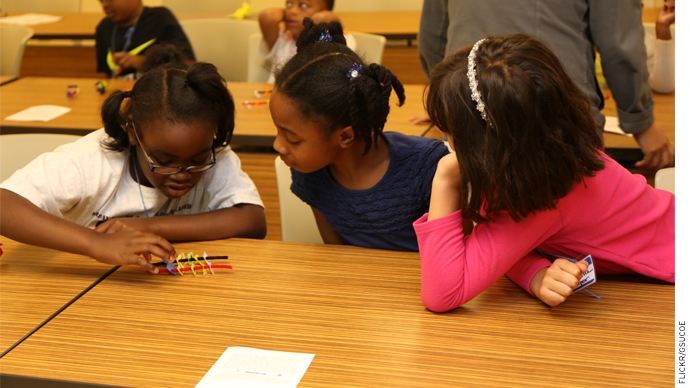
Last month I suggested that grouping New York City schoolchildren by age rather than ability would address two issues that stymie the NYC Department of Education: strict birthday cut-offs that ignore readiness and the perennial shortage of Gifted and Talented seats. In this post I cited a report which asserted that, in some American classrooms, as many as fifty percent of students are performing above grade level, and, in the majority of schools, at least ten percent are.
This assessment was done in order to encourage differentiated instruction within the classroom. But I’d like to propose it proves something even simpler: The US bar is simply set too low. For all children.
In his book, “Dumbing Down America: The War on our Nation’s Brightest Young Minds (And What We Can Do To Fight Back),” author James R. Delisle waxes poetic about a “gifted” student from Romania capable of learning algebra in the 4th grade. What this education expert apparently does not realize is that ALL children in Romania – as well as many parts of Eastern and Western Europe, and Asia – begin studying algebra in 4th grade. If they’re capable of this, why aren’t American students?
In fact, a recent study confirmed that Kindergarten math skills improve when all children are instructed using methods otherwise reserved for the “gifted.” And with such a solid foundation, they can continue to progress at “accelerated” speeds in subsequent grades.
Children in the US are diagnosed with Attention Deficit Hyperactivity Disorder (ADHD) at much higher rates than those in other countries: twenty times higher than in France! And kids in Finland spend much less time in Special Ed before they are mainstreamed into regular classrooms – where separate G&T isn’t a thing.
Could it be that American children don’t overwhelmingly suffer from neurological conditions? Could it be that an overwhelming number of American children are simply bored at school?
I know I was the kid who got up and wandered around the classroom when the material was too simple. And my own son rebelled against mindless busywork by refusing to do it. He almost got stuck with a diagnosis of Oppositional Defiance Disorder, until more challenging assignments (and a talking to from me about how if you want to be advanced to the higher math group, you need to demonstrate that you can do the work in the lower; that’s just life, dude) magically fixed the problem.
Currently, NYC’s only accelerated public schools that teach the standard curriculum a year in advance are the five citywide G&T schools, three in Manhattan, one in Brooklyn and one in Queens. (Better luck next time, Bronx and Staten Island.) Kids need to score above the 97th percentile on a standardized test in order to enter the admissions lottery and, every year, about two-thirds of those who qualify are shut out.
But what if NYC were to tweak the system? What if they opened another hundred accelerated schools (and maybe even throw the two left-out boroughs a bone this time)? And what if, instead of testing in, parents were given a choice about whether or not to enroll their children?
Such an option already exists for families who want a progressive approach to the standard curriculum. They can apply to public schools like Central Park East or Manhattan School for Children, which promise not to “teach to the test.” among other progressive tenets. So why not give parents looking for more academic rigor the same opportunities?
It wouldn’t cost the DOE anything extra, since the children would be taking up the same amount of space in public school buildings and would not require hiring any extra teachers. The curriculum is already there: all it needs is to be taught a year – or even more – ahead. It would even save the city the expense of separate G&T testing!
Nobody would be forced to attend such a school, and if children have trouble keeping up, their parents might decide to move them elsewhere. If demand was high, more accelerated schools could be added. If demand was low, some would be removed. The DOE would be responsive to what the parents want, for a change, instead of making the decision for them. Families could still opt to keep their kids on the current track, for any reason. But, at least, the choice would be up to them, rather than a proven, flawed testing system or an arbitrary lottery. And a US accelerated education otherwise reserved for a minority of “gifted” students – what in most of the world would be considered standard for all – would be available to any student who wanted one. The worst thing that would happen is that the kids currently performing above grade level would be more challenged and engaged at school. The best that would happen is raising the American education level across the board.
— Alina Adams
Alina Adams is a New York City mom of 3 school-age children. Her website is NYC School Secrets. This post originally appeared on New York School Talk.


